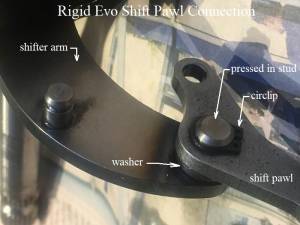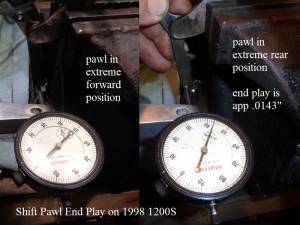REF: Service Procedures 11B
Why There is So Much Slop in the 1991-2003 Shifter Shaft
From the shifter mechanism to it's related parts, there are a lot of clearances that allow movement along the shifting path.
Some of these issues can be helped along but the whole shift chain has to be considered.
Shifter shaft assembly:
There is natural free space for the shaft to dangle in all directions freely with the primary cover off.
The primary cover holds the shaft in place and is said to make the shaft assembly rigid once the shaft runs through the cover bushing.
But the cover only “sets” the shaft position and gives each end of the shaft a “shoulder to lean on”.
The cover will put the shifter in a different place than you can guesstimate with the cover off also.
Forces put on the shaft can still move it around including the other parts in the shifting chain.
One might wonder why the MoCo allowed so much free play in the moving parts.
Below are examples of where the looseness comes from.
Rear shaft bushing to mounting plate clearance:
When you set the shifter assembly into it's hole in the primary compartment, the rear bushing is not a press fit into it's bore.
It's a loose fit (.002“ +/- clearance).
There is a small clearance between the bushing and the shifter mounting plate that allows slight axial movement of the shaft in and out of the bushing bore.
If that clearance is too wide, the shaft can slide in and out of the that bore more and create more slop in the assembly chain.
But due to the other clearances, this is just a small issue and reducing that clearance will help make the shaft “want” to spring back to this position somewhat.
But tightening this connection won't change a lot in the big picture.
The shimming will also “relax” the shaft back to that position somewhat after being stressed from elsewhere.
The bore is app .713” deep and the bushing is app .400“ long.
How far the shaft moves in and out of the bore is minimal at best and will change (slightly) when the shaft shifts but it's still no effect on the bore depth.
There is a also clearance between the rear bushing and the mounting plate due to the coil positioning on the return spring.
You may have no free horizontal play thru the bushing / shaft movement (IF) you don't let the coil space on the spring collapse.
I've got about .050” play there if I push the plate over the free space near the coil.
| Case bore dims for shifter shaft. 1) | ||
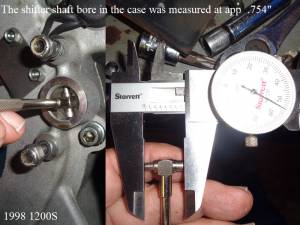 | 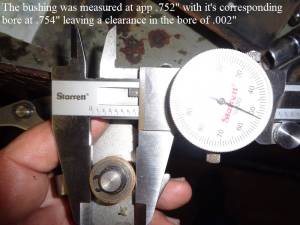 | 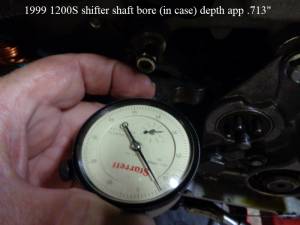 |
The shifter shaft dangles with no return to center when the primary cover is off.:
There is clearance between the rear bushing ID and the shaft which allows the shaft to have a small natural lean tendency.
I've found between 4 and 6 degrees of angle shift from extreme up and down placement of the shaft with the primary cover off.
I measured that to be roughly an average of .650“ of up and down travel between extremes.
There is enough clearance in the shaft to bushing and bushing to bore areas to allow this much travel of the shaft.
But the main contributor to the shaft lean is the return coil spring in front of the mounting plate.
Coil springs don't sit flat (or flush). The spring only touches the mounting plate where the coils are ending.
As the coils rise, they lift off the plate and washer on each end.
The areas of the lift are left as open space and the assembly has a huge natural lean tendency there.
Again, if the rear bushing had a smaller ID (clearance to shaft), there would be less lean-ability.
But the void areas of the coil spring are the main leaning factor of the shaft.
And the fact that the mounting plate does not actually hard mount to the shaft.
The mounting plate is bound to the shaft against and teetering on the return spring.
So whatever direction the spring moves, the shaft follows (not being bound by the mounting plate).
The hole in the mounting plate is also bigger than the shaft (assumed to allow said movement).
| This clearance around the spring coil gives the shift arm's willingness to lean. 2) |
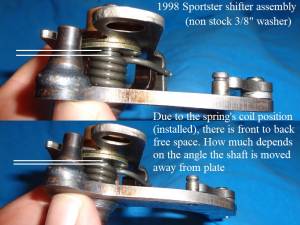 |
The shaft sits where the shaft sits with the cover on (somewhere in between the extremes) and the cover only steadies the shaft while it's dormant.
Depending on what force is applied on the shaft and from where, the shaft is nudged that direction and equal to force applied (given it's restrictions).
The front and rear shaft bushings take a lot of the force but are not responsible for making the shaft rigid in operation.
The primary cover will expand / morph like all the other parts that heat up and the clearances expand or shrink with them.
The shaft return spring length will change the farther it is compressed which also changes the other clearances.
Forces pushing against the shifter shaft and related parts are numerous.
The outer end of the shifter shaft, you'd normally think does nothing but sit and turn (push or pull on the shift pedal and that's all you can see the shaft do).
However, when up or down pressure comes to the shaft, it pulls up or down on the inner end of the shaft (business end).
In reality, the inner shaft end is forced up and forward on up shift and down and rearward on downshift.
That same amount of force is applied (in the opposite direction) on the outer end of the shaft as well.
So the shaft ends up with a (fore or aft) twisting force due to whichever direction of shift position causes it.
And the role of the outer bushing and cover is expanded (to allow the shifter to use these forces to turn the shift drum).
Same situation as the cams in the gearcase.
Without the cam cover, there is no way for the cams to contain the downforce from lifting the valves.
The bushing in the primary cover will end up with shaft impressions (indentions) all the way around it's O.D.
Picture a block of aluminum set in a bench vise and a round hard metal rod chucked up against it.
If you tighten the vise and then remove these pieces, you'll find one elongated mark in the aluminum block.
Now do this again but this time move the rod to a different location and tighten the vise, now you've got two indentions and so on.
A used bushing in the cover will have many indentions from pressure being exerted in all directions.
Each indention adds future clearance space. The outer bushing below looks worse than it is due to the closeup view.
But it examples the forces on the shaft in operation which comes from many different directions (both internal and external.)
| Pawl to shift travel directions. 3) | Shaft outer bushing takes a lot. 4) | Forces on the shifting chain. 5) |
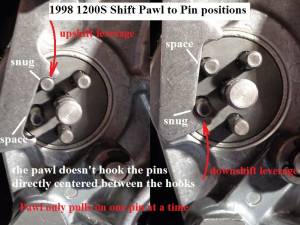 | 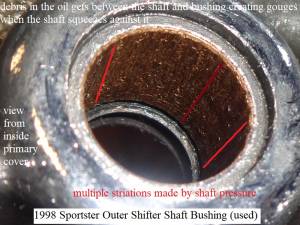 | 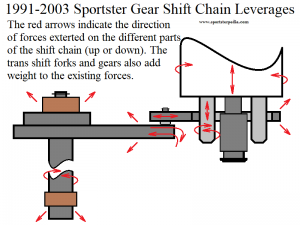 |
The shift pawl has designed end play at the shift arm.
The shift pawl is attached to the shifter arm stud with a thick washer between them and a circlip on the end.
The washer is flat edged on one side and has a rounded edge on the other resulting a “want” to lean.
The pawl end play near the bottom hook in the pic below was measured at .043” (3.6322mm).
XLForum member, xLoneRiderx, measured app .197“ (5mm) of shift pawl end play at the tip on his pawl. 6)
End play will be variable due to wear and probably quality control on the parts themselves as well as the point that is measured.
The pawl is responsible for lifting or lower the pins on the shift drum (which cause the drum to turn).
When the pawl lifts up, down force is placed on the inner end of the shifter shaft and up force is placed on the outer end of the shaft.
Likewise, when the pawl pushes down, up force is placed on the inner shaft end and down force is on the outer shaft end.
If the pawl is forced to lean outward at the same time, the shaft is also forced from that direction as well.
How hard or soft you use the shifter also plays a part in the amount of force on the shifter.
Easing into gear applies the least amount of extra force and stomping into gear applies the most.
But soft shifting into gear can also cause a false neutral and grinding of gears.
The speed at which the drum is turned is controlled by the speed of foot action and that speed equals faster movement of the forces against the shaft.
Hard shifting accelerates forces in the shift chain.
So one could say a (median) pressure should be used to shift gears. But the truth is all mechanical things fail in time.
Just be aware that you can speed up the wear on the moving parts with hard shifting.

